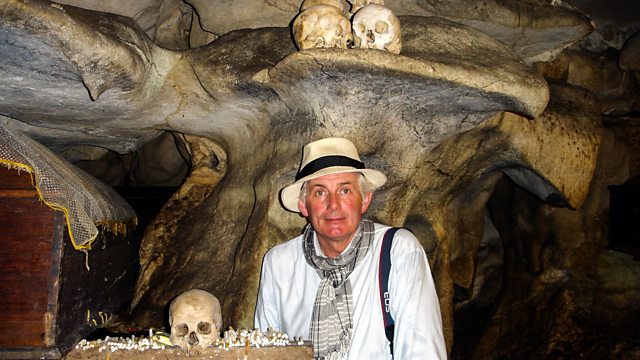Around the World in 80 Treasures episode 3 – Australia to Cambodia: Giant termite mounds, edible juicy ants and erotic cave paintings are the treasures Dan Cruickshank unearths in the outback.
In Dan’s view, even the brilliance of Sydney Harbour can’t rival the artefacts of ancient Australia. Dan then moves on to Indonesia and meets the Torajan people of Sulawesi for whom, with their elaborate funerals and continued contact with loved ones after they have died, the line between life and death is very different to that in the west.
Dan’s excitement is palpable as he visits the highlight of his trip so far – the temples of Angkor Wat and the 12th-century city of Angkor Thom in Cambodia. A golden elephant is Dan’s final prize in Thailand – another wonder of the ancient world.
Dan’s visit to Indonesia and Thailand was made before the devastation wrought by the Indian Ocean tsunami and earthquake in 2004.
Around the World in 80 Treasures episode 3 – Australia to Cambodia
Angkor Wat
Angkor Wat is the largest religious structure (temple complex) in the world by land area, measuring 162.6 hectares (1.626 km2; 402 acres), located in Cambodia. Originally constructed as a personal mausoleum for the Khmer King Suryavarman II, dedicated to Vishnu in the early 12th century, it was converted into a Buddhist Temple towards the end of 12th century and remains so in the present day.
The temple was built by Suryavarman II in the early 12th century in Yaśodharapura (Khmer: យសោធរបុរៈ, present-day Angkor), the capital of the Khmer Empire, as the state temple for the Empire.
As the best-preserved temple at the site, it is the only one to have remained a significant religious centre since its foundation. The temple is at the top of the high classical style of Khmer architecture. Today, it is one of the most important pilgrimage sites for Buddhists in Cambodia and around the world. It has become a symbol of Cambodia, appearing on its national flag, and it is the country’s main tourist attraction. Angkor Wat played a major role in converting Cambodia into a Buddhist Nation.
Angkor Wat combines two basic plans of Khmer temple architecture: the temple-mountain and the later galleried temple. It is designed to represent Mount Meru, home of the devas in Hindu and Buddhist cosmology. It lies within a moat more than 5 kilometres (3 mi) long and an outer wall 3.6 kilometres (2.2 mi) long. The temple has three rectangular galleries, each raised above the next. At the centre of the temple stands a quincunx of towers. Unlike most Angkorian temples, Angkor Wat is oriented to the west. Scholars are divided as to the significance of this. The temple is admired for the grandeur and harmony of its architecture, extensive bas-reliefs, and statues of Buddhas and Devas that adorn its walls.
